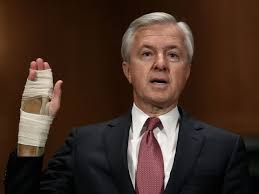After Circling the Wagons: Wells Fargo’s CEO Finally Falls
 The Wells Fargo scandal represents a textbook case of compliance and culture failures. Recently, the scandal and Wells Fargo’s defensive crisis management strategy resulted in CEO Stumpf’s resignation. Stumpf’s demise was inevitable. He will go down in history as the only CEO of a major bank forced to resign in the aftermath of a public scandal.
The Wells Fargo scandal represents a textbook case of compliance and culture failures. Recently, the scandal and Wells Fargo’s defensive crisis management strategy resulted in CEO Stumpf’s resignation. Stumpf’s demise was inevitable. He will go down in history as the only CEO of a major bank forced to resign in the aftermath of a public scandal.
It is important to review what happened at Wells Fargo with a broad view of corporate culture. It is too easy to blame the scandal on a sales incentive program that was based on having account managers sell at least eight new accounts to each existing customer. This incentive put enormous pressure on Wells Fargo account managers, supervisors and regional managers.
The question to examine is why was this incentive program adopted? Who was responsible for designing this sales goal, enforcing it, and implementing it across the bank? The questions boil down even further to who in senior management was aware of the program and who was responsible for allowing it to continue?
Wells Fargo’s sales goals appear to be inflexible and unworkable. You can blame the structure of the goals themselves but there were managers and executives behind these goals. Managers and executives appear to have acceded and even embraced this program.
Wells Fargo’s deficient culture became even more evident when problems started to develop. Consumers who raised complaints were quickly silenced by being forced into arbitration proceedings. Complaints were quickly resolved. Supervisors and sales staff brushed away possible concerns by blaming the problems on individual bad actors.
To show you how bad it was, Wells Fargo’s corporate culture had no interest in uncovering wrongdoing and fixing problems. Employees who called into the hotline to report the problems occurring with the opening of fraudulent accounts were not just ignored but were fired from the company. According to press reports, as many as five employees were fired for raising concerns about Wells Fargo’s fraudulent account problem.
Wells Fargo’s culture was premised on circling the wagons. Wells Fargo managers responded with defensive denials, almost a groupthink of delusions. Wells Fargo’s culture did not embrace reports of wrongdoing but punished those who raised concerns in order to continue with a culture premised on a misunderstanding and paranoid strategy of preservation.
As the walls of defense started to crumble under government investigations, eventually Wells Fargo had to acknowledge and admit the problems that developed. Even when the CFPB settlement for $185 million was announced, senior executives sought to protect themselves by blaming lower level managers, citing the firing of 5300 employees and claiming that this was not a matter that was known or should have been known by senior management.
Wells Fargo’s crisis management strategy, to the extent there was one, reflected the long-simmering rotten culture eating away at Wells Fargo. Stumpf’s appearances on Capitol Hill reflected his complete lack of awareness and sensitivity to the real and significant harm to consumers. Stumpf’s message was tone-deaf and once again reflected a glaring absence of accountability.
Stumpf and senior executives clearly had little understanding or interest in attending to corporate culture. Any company that fires employees for raising concerns is, by definition, a company that has no interest in promoting trust or a positive culture of compliance and ethics. As Senator Elizabeth Warren told Stumpf during a Hearing on the scandal stated, “Your definition of accountable is to push the blame to your low-level employees who don’t have the money for a fancy PR firm to defend themselves.”
 In Stumpf’s mind, he probably has not understanding as to why he is being “blamed” for Wells Fargo’s woes and scandal. Unlike many other banking scandals, the misconduct at issue in Wells Fargo was basic – account managers were pressured to open fraudulent accounts and credit cards. These were not sophisticated banking transactions; they were basic and they were wrong.
In Stumpf’s mind, he probably has not understanding as to why he is being “blamed” for Wells Fargo’s woes and scandal. Unlike many other banking scandals, the misconduct at issue in Wells Fargo was basic – account managers were pressured to open fraudulent accounts and credit cards. These were not sophisticated banking transactions; they were basic and they were wrong.
Wells Fargo’s misconduct occurred over 5 to 10 years. No one reported on it during that time, and no one knew about it until the CFPB settlement was announced. When pressed, Stumpf tried to blame the scandal on Crrie Tolstedt, the senior executive in charge of Wells Fargo’s branches when the customer abuse took place.
Wells Fargo now has to clean house. Changing its culture may not occur until the Justice Department completes its criminal investigation. If Wells Fargo had an ounce of sensitivity and resolve to fix its problems, they would get started now and begin to embrace change. Given its recent performance, I am not so confident that Wells Fargo will implement meaningful change.















1 Response
[…] Michael Volkov wrote about the Wells Fargo case in his blog: “Any company that fires employees for raising concerns is, by definition, a company that has no […]